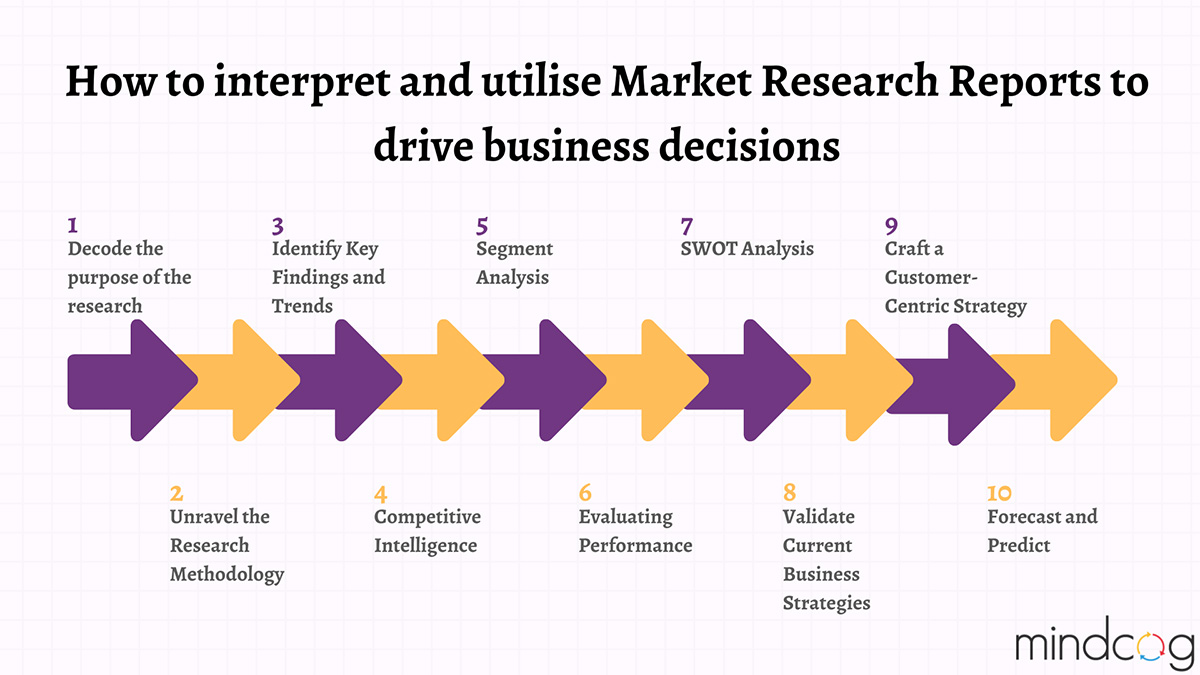Market research reports are valuable assets for businesses seeking to make data-driven decisions and achieve sustainable growth. These comprehensive documents provide crucial insights into market trends, customer preferences, and competitive landscapes.
However, to truly harness the power of market research reports, businesses must adeptly interpret the data and convert it into actionable strategies.
In this article, we will delve into the essential steps for interpreting and effectively utilizing market research reports, enabling businesses to drive success and expansion with data-driven precision.

- Decode the purpose of the research: Before immersing in the depths of the market research report, it is vital to grasp the research objective. Uncover the core questions the report seeks to address: whether it’s gauging market trends, understanding customer preferences, or assessing new product viability. This clear understanding will guide us to navigate the report efficiently, honing in on relevant sections and extracting valuable insights.
- Unravel the Research Methodology: Before diving into the data, it is crucial to comprehend the research methodology employed in conducting the market research. Assess the sample size, target audience, data collection techniques, and the statistical methods employed in the analysis. Being aware of the research’s limitations and potential biases will provide a more accurate perspective on the report’s findings.
- Identify Key Findings and Trends: Market research reports often present valuable data on market trends and consumer behaviour. Scan through the report to identify key findings and emerging trends. Look for patterns, outliers, and any significant shifts in consumer behaviour. Pay attention to growth opportunities and potential threats that could impact your business.
- Competitive Intelligence: The competitive analysis section of the market research report is a goldmine of information. Analyze the competitor analysis section of the market research report to gain a comprehensive understanding of your rivals’ strengths and weaknesses. Identify areas where your business can differentiate itself and capitalize on untapped opportunities. Leveraging competitor insights will help you build a competitive advantage and refine your market positioning.
- Segment Analysis: Market research reports often include data segmented by demographics, geographies, or other relevant factors. Analyze how different customer segments respond to the research findings and how these insights align with your business goals. Tailor your marketing strategy, messages, and products to resonate with specific consumer groups.
- Evaluating Performance: Market research reports often include feedback on products or services from consumers. Utilize this information to assess customer satisfaction, identify scope for improvement, and refine your offerings to meet customer needs. Implementing product/service enhancements based on customer feedback can significantly impact customer loyalty and retention.
- SWOT Analysis: Conduct a SWOT analysis
Strengths
Weaknesses
Opportunities
Threats
based on the market research findings. This exercise will help you understand your business’s internal capabilities and external market factors that could impact your growth prospects. Develop strategies to leverage strengths, address weaknesses, seize opportunities, and mitigate threats.
- Validate Current Business Strategies: Use the market research data to validate your current business strategies. Assess whether your existing products or services align with customer demands and market trends. Identify gaps and areas of improvement to fine-tune your offerings and stay ahead of the competition.
- Craft a Customer-Centric Strategy: Success hinges on understanding customer preferences and challenges. Capitalise on market research insights to foster a customer-centric approach. Tailor your marketing messages, enhance customer service, and personalise offerings to cater directly to the unique needs of your target audience. By placing customers at the core of your business, you’ll forge stronger connections and foster loyalty, propelling your brand to new heights.
- Forecast and Predict: Market research reports often include forecasts and predictions for future market trends. Use this information to make informed business decisions and develop long-term strategies. Continuously monitor market trends, customer behaviours, and competitor activities. Regularly update your business strategies based on real-time insights to maintain a competitive edge.
Conclusion: Market research reports serve as powerful tools for businesses to gain a deep understanding of their target market, customers, and industry dynamics. By effectively interpreting and utilising the data provided in these reports, companies can make well-informed decisions that drive business growth and success.
Remember that successful market research integration requires a proactive and data-driven approach, where continuous learning and adaptation are key to staying ahead in today’s dynamic business landscape.

